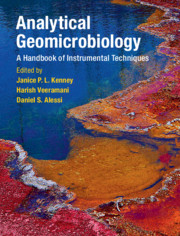Book contents
- Analytical Geomicrobiology A Handbook of Instrumental Techniques
- Analytical Geomicrobiology
- Copyright page
- Contents
- Contributors
- Foreword
- Part I Standard Techniques in Geomicrobiology
- Part II Advanced Analytical Instrumentation
- Part III Imaging Techniques
- Part IV Spectroscopy
- 9 X-ray Diffraction Techniques
- 10 Application of Synchrotron X-ray Absorption Spectroscopy and Microscopy Techniques to the Study of Biogeochemical Processes
- 11 Bacterial Surfaces in Geochemistry – How Can X-ray Photoelectron Spectroscopy Help?
- 12 Applications of Fourier-transform Infrared Spectroscopy in Geomicrobiology
- 13 Mössbauer Spectroscopy
- Part V Microbiological Techniques
- Index
- References
11 - Bacterial Surfaces in Geochemistry – How Can X-ray Photoelectron Spectroscopy Help?
from Part IV - Spectroscopy
Published online by Cambridge University Press: 06 July 2019
- Analytical Geomicrobiology A Handbook of Instrumental Techniques
- Analytical Geomicrobiology
- Copyright page
- Contents
- Contributors
- Foreword
- Part I Standard Techniques in Geomicrobiology
- Part II Advanced Analytical Instrumentation
- Part III Imaging Techniques
- Part IV Spectroscopy
- 9 X-ray Diffraction Techniques
- 10 Application of Synchrotron X-ray Absorption Spectroscopy and Microscopy Techniques to the Study of Biogeochemical Processes
- 11 Bacterial Surfaces in Geochemistry – How Can X-ray Photoelectron Spectroscopy Help?
- 12 Applications of Fourier-transform Infrared Spectroscopy in Geomicrobiology
- 13 Mössbauer Spectroscopy
- Part V Microbiological Techniques
- Index
- References
Summary
Processes occurring at surfaces and interfaces are very important in environmental systems, necessitating surface-specific characterization tools that can help us understand processes at and specific properties of surfaces and interfaces, and their role in biogeochemical systems. This chapter describes the use and application of X-ray photoelectron spectroscopy (XPS) to study interfacial processes of relevance for geomicrobiology. Examples are given from studies determining cell wall composition, acid–base properties, cell surface charge, metal adsorption onto bacterial cells, and bacterial surface–induced precipitation of secondary minerals. As XPS is an ultrahigh-vacuum technique, several sample preparation methods have been applied to enable analysis of bacterial samples, including analysis of freeze-dried samples as well as frozen bacterial suspensions. These are described and discussed alongside advantages and disadvantages of different approaches, with a special focus on fast-freezing and the cryogenic technique.
- Type
- Chapter
- Information
- Analytical GeomicrobiologyA Handbook of Instrumental Techniques, pp. 262 - 287Publisher: Cambridge University PressPrint publication year: 2019
References
11.4 References
- 4
- Cited by



